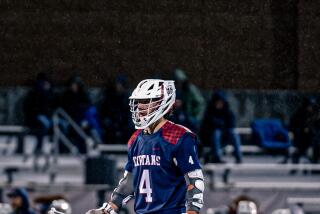Gait’s Greatness Defines a Sport
- Share via
DENVER — He has been called the Michael Jordan of lacrosse, a player so gifted he invented moves that wound up being banned, broke scoring records and led teams to championships at the college and professional levels.
But Gary Gait’s contribution to the sport goes beyond highlight reels and record books. Gait, who plans to retire at the end of the season from the Colorado Mammoth, has helped change what for years was considered an East Coast prep school activity into one of the fastest-growing team sports in the United States.
“He’s more than Michael Jordan,” said National Lacrosse League commissioner Jim Jennings. “He’s probably the person who’s contributed the most to the sport of lacrosse.”
He hasn’t done it alone, of course. For most of his career, Gait played alongside or against his identical twin, Paul. The younger Gait, by 3 minutes, even came out of retirement last month to help 38-year-old Gary try for one last NLL championship.
Lacrosse is a niche sport by almost any definition, with a small but rabid fan base. For decades, the game has been most popular in New England, where it has a long tradition of being played at high schools and Ivy League colleges, and in Canada, where its similarities to hockey and relatively inexpensive equipment made it a popular indoor diversion. Like hockey, players rely on speed, agility and stick skills to defend and score.
When Gary and Paul Gait came to Syracuse in 1987 from Victoria, British Columbia, coach Roy Simmons Jr. knew he had something special.
“What I saw was spellbinding. Not one, but two identical twins with unbelievable talent,” said Simmons, who coached the Orangemen to six NCAA titles -- three with the Gaits -- before retiring in 1998. “They were physically strong, but better than that they had great skills.”
The Gaits stand 6-foot-1 and weigh about 225 pounds, bigger than typical lacrosse players -- but they were fast and seemingly could score at will. Rather than making them goal-scoring attackers, Simmons let them run the entire field as midfielders, playing both offense and defense. And they often put on a show.
During a game in the 1988 NCAA tournament, Gary Gait twice pulled off what still is considered one of the most spectacular moves in lacrosse history, leaping over the crease line and slamming the ball home into the 6-foot net from behind. The “Air Gait” is now banned in high school and college lacrosse, as well as in the NLL.
By the twins’ senior year, Syracuse was so dominant that opposing teams were dropping games for fear of being embarrassed. Simmons often benched the Gaits during blowouts.
The brothers were NLL first-round draft picks in 1990. Gary Gait quickly succeeded, winning the first of his three championships and being named rookie of the year. But there were no endorsement deals and little national exposure for the sport’s best players.
“None of the manufacturers had players representing them. That was nonexistent. Team sponsorship wasn’t really existent,” Gary Gait recalled, sitting in the Mammoth’s home arena, the Pepsi Center. “We went into new territory with all that stuff to try and take lacrosse to the next level. It’s grown considerably since then.”
The Gait brothers were the first to win endorsement deals from lacrosse equipment manufacturers and they helped attract the first lacrosse article in People magazine.
But it wasn’t just about the money. Over the years, Gary Gait also coached women’s lacrosse at Maryland and started a company, NDP Lacrosse, to help high school players connect with college coaches.
Some of his teammates remember looking up to him when they were young.
“Just seeing the two Gait brothers play and wanting to be that good added a little more drive,” said Gavin Prout, one of the Mammoth’s leading scorers, who watched the brothers while he was a junior player in Canada. “It gave a sense of direction of where I wanted to be in lacrosse.”
Added Simmons, the Syracuse coach: “Up until Paul and Gary, we never had heroes in the game. They’ve been the Johnny Appleseeds of the game.”
Lacrosse at all levels is growing rapidly across the United States, according to U.S. Lacrosse, the national governing body of the sport. Since 1995, varsity high school programs have increased by nearly 200 percent -- lacrosse led all NCAA-sanctioned sports in growth between 1994 and 2003.
The NLL expects to add two to four expansion teams to its 10-city roster next season and attendance has grown at least 10 percent during each of the last four seasons, Jennings said.
Dean Bonham, founder of the sports marketing firm The Bonham Group, believes professional lacrosse could became as popular as Major League Soccer in the United States in the next 15 to 20 years.
“Lacrosse is a sport that has roots here in the United States that American sports fans can relate to immediately,” Bonham said. “The product is interesting, fast moving and enjoyable.”
Gait’s retirement from the Mammoth won’t take him far from the game -- or even the league. Jennings expects him to move into a front office position with the Mammoth, and Gait still plans to play and coach for the outdoor Major League Lacrosse’s Baltimore Bayhawks.
“It’s been great. Everything that I’ve done has been more than I’ve expected,” Gait said.
“I feel pretty good about where the game’s going and how it’s getting there.”
More to Read
Go beyond the scoreboard
Get the latest on L.A.'s teams in the daily Sports Report newsletter.
You may occasionally receive promotional content from the Los Angeles Times.









